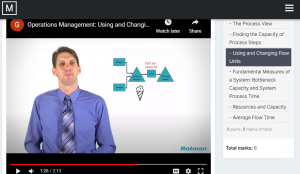Support within a range of digital learning contexts at the University of Toronto is illustrated in the innovative initiatives featured below.
- French Language Collaboration with Wikis
- Symbolic Logic Video and Discussion
- Environmental Science Virtual Office Hours
- Operations Management Randomized Quiz Questions
French Language: Collaboration Wikis
 The French in Business Communication (FLS466) curriculum is based on tasks that simulate a job search trajectory. Each task aims to develop different linguistic competency and problem-solving tasks. The goal of this writing activity is to have students work in a team to build an imaginary company and write a job offer using a wiki. Students begin by collaborating online to edit, assess, and revise their group’s writing tasks in the wiki. In the subsequent class, students collectively read and evaluate their peer groups’ work based on the instructor’s evaluation rubric. The collected feedback results are shared with the authors. After a group discussion, students have to make discerning decisions on helpful comments to improve their final written assignments.
The French in Business Communication (FLS466) curriculum is based on tasks that simulate a job search trajectory. Each task aims to develop different linguistic competency and problem-solving tasks. The goal of this writing activity is to have students work in a team to build an imaginary company and write a job offer using a wiki. Students begin by collaborating online to edit, assess, and revise their group’s writing tasks in the wiki. In the subsequent class, students collectively read and evaluate their peer groups’ work based on the instructor’s evaluation rubric. The collected feedback results are shared with the authors. After a group discussion, students have to make discerning decisions on helpful comments to improve their final written assignments.
Student Response
Students really appreciate the collaborative nature that allows them to work with multiple perspectives and ways to process ideas.
“I learned to work in a team, in times we had opposite ideas but we learned to negotiate.”
“I find this experience excellent because I love working with others. You have a chance to collaborate and your learning develops.”
Rosa Junghwa Hong, Assistant Professor, Teaching Stream, Department of Language Studies, UTM
Symbolic Logic: Video and Discussion
 Modern Symbolic Logic (PHL245) has lots of fully online aspects that support student learning. The online portion of the course includes the use of videos, which are a mixture of core lecture materials and practice problem demonstrations. There is also a course discussion forum for students to ask questions and get feedback fast. This hybrid course model maximizes the efficiency of a student’s time. With online options students can watch videos and use the forums whenever it fits into their schedule.
Modern Symbolic Logic (PHL245) has lots of fully online aspects that support student learning. The online portion of the course includes the use of videos, which are a mixture of core lecture materials and practice problem demonstrations. There is also a course discussion forum for students to ask questions and get feedback fast. This hybrid course model maximizes the efficiency of a student’s time. With online options students can watch videos and use the forums whenever it fits into their schedule.
Student Response
Students really appreciate the flexibility that the hybrid course provides so that they can learn on their own time and at their own pace. Many students have said that the ability to re-watch sections of the videos that they find challenging eliminates the stress found in a typical classroom environment of scrambling to take notes and pay attention at the same time. Students also often mention how surprised they are with the amount of community development the course provides.
Alex Koo, Assistant Professor, Teaching Stream, Department of Philosophy, FAS
Environmental Science: Virtual Office Hours
 In this online Environmental Science course (ENV100) the instructor seeks to engage students and humanize online teaching with live online chat sessions. At set times during the term, such as before quizzes or tests (the night before each quiz, Blackboard Collaborate sessions are available for one or two hours in the evening for students to drop in and out to ask questions. Collaborate allows the instructor to record transcripts of the chat sessions, so after each session ends, it can be shared with all students, allowing those who can’t attend the chat the flexibility to catch up later.
In this online Environmental Science course (ENV100) the instructor seeks to engage students and humanize online teaching with live online chat sessions. At set times during the term, such as before quizzes or tests (the night before each quiz, Blackboard Collaborate sessions are available for one or two hours in the evening for students to drop in and out to ask questions. Collaborate allows the instructor to record transcripts of the chat sessions, so after each session ends, it can be shared with all students, allowing those who can’t attend the chat the flexibility to catch up later.
Student Response
With her varied communication strategies, including offering online office hours Barb Murck found that 93% of her students reported that they felt as connected with her, and their peers, as a regular face-to-face course.
Barb Murck, Member of the UofT President’s Teaching Academy and Professor, Teaching Stream, Department of Geography, UTM
Operations Management: Randomized Quiz Questions
 This course with online sessions uses an assessment tool, called UTORMAT, that generates, presents and automatically marks sets of randomized algorithmically generated questions (besides more standard type questions such as multiple choice and true/false or short answer). This type of question is in particular very useful, where multiple calculations need to be performed on a certain scenario. The tool has been in use in the last few years for several courses at UTM as well as for many sections of RSM270 at no cost for the students. Images and videos can be integrated into the questions and the questions can be set up to allow for multiple trials for each part with instant feedback and hints to guide the students through the entire question.
This course with online sessions uses an assessment tool, called UTORMAT, that generates, presents and automatically marks sets of randomized algorithmically generated questions (besides more standard type questions such as multiple choice and true/false or short answer). This type of question is in particular very useful, where multiple calculations need to be performed on a certain scenario. The tool has been in use in the last few years for several courses at UTM as well as for many sections of RSM270 at no cost for the students. Images and videos can be integrated into the questions and the questions can be set up to allow for multiple trials for each part with instant feedback and hints to guide the students through the entire question.
Student Response
Students appreciate how the tool provides instant feedback on their answers and offers the opportunity to read a hint and to rethink and have another attempt. Randomizing the questions gives the students the chance to talk to each other as well about the concepts, without running the risk of simply sharing the correct numerical answers.
Gerhard Trippen, Associate Professor, Teaching Stream, Rotman School of Management and Department of Management, UTM